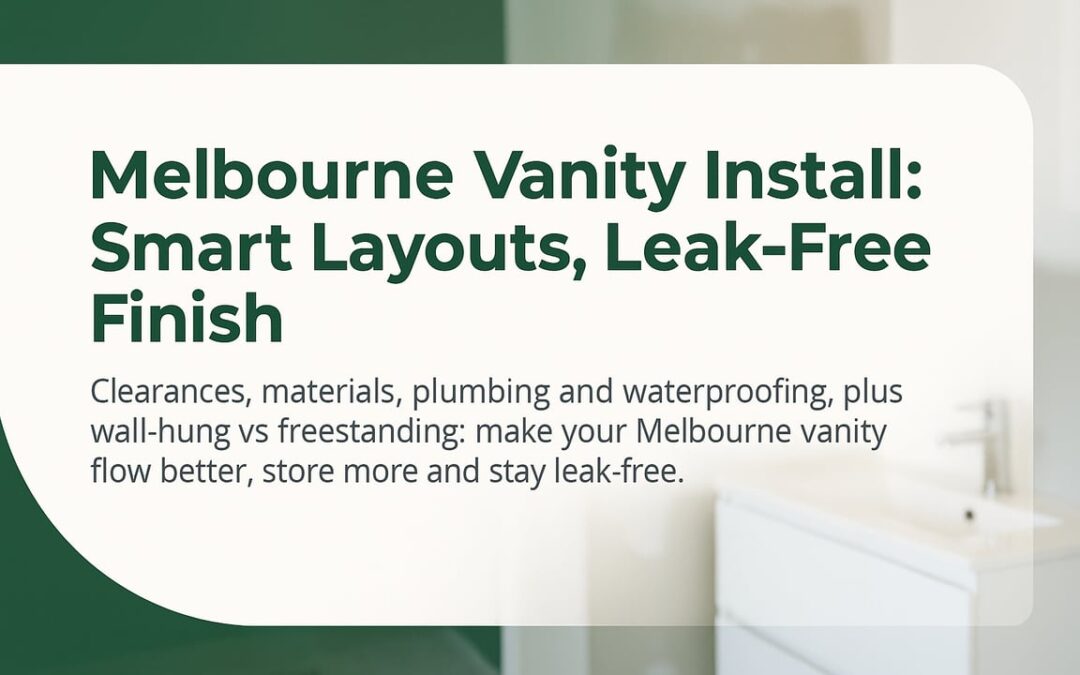Bathroom Vanity Installation Melbourne: A Homeowner’s Playbook for Smarter Layouts, Lasting Materials, and Leak-Free Finishes
Small upgrade, big impact. Replacing or repositioning a vanity can improve storage, traffic flow, cleaning, and even ventilation performance. This guide shares practical, Melbourne-specific tips so informed decisions can be made with confidence.
Why vanities punch above their weight in a renovation
- Traffic and ergonomics: The vanity often sets the circulation width, mirror height, and task-light position.
- Storage and cleaning: Drawer-based storage reduces bending and clutter; wall-hung options create visible floor for an easier clean.
- Moisture control: Better set-out can keep timber joinery away from splash zones and improve airflow around plumbing voids.
- Design coherence: The benchtop and basin lines unify tile set-outs, tapware finishes, and mirror proportions.
Planning a full bathroom overhaul in Melbourne and want a coordinated process across design consultation, tiling, and finishing? Explore bathroom vanity installation Melbourne as part of an end-to-end renovation pathway.
Step 1: Measure, then decide on freestanding vs wall-hung
- Clearances: Aim for 800 mm minimum pathway where possible. In compact rooms, 700 mm can function if doors and drawers are considered.
- Heights that work: Typical benchtop height is 850–900 mm; vessel basins often suit lower tops (approx. 820–850 mm) to keep rim height comfortable.
- Freestanding: Easier to install on timber subfloors; more forgiving in renovations where wall plumb is imperfect.
- Wall-hung: Creates visual space and improves cleanability. Requires solid fixing points and services planning within the wall cavity.
Step 2: Plumbing orientation and Melbourne subfloor realities
Service positions affect cost and complexity. Melbourne homes span timber subfloors, slab-on-ground extensions, and apartment plumbing stacks. Each has constraints.
- Timber subfloors: Waste and water can be adjusted with fewer structural implications if access exists below. Check for termite barriers and ventilation.
- Concrete slabs: Moving wastes can trigger cutting and structural review. Keeping the vanity near existing services controls cost.
- Apartments: Stacks and acoustic rules limit relocation. Consult building management for approvals and allowable work windows.
- Tap position: Wall mixers free up benchtop space and simplify cleaning; hob-mounted taps ease maintenance and reduce wall penetrations.
Step 3: Materials that survive moisture and time
- Benchtops: Porcelain or sintered stone excels for stain, heat, and scratch resistance. Engineered stone is reliable; timber tops look great but need disciplined sealing and splash control.
- Cabinetry: Moisture-resistant substrate (MR) with quality edge sealing is key. Look for durable laminates or 2-pack finishes in splash-prone zones.
- Hardware: Soft-close, high-quality runners and hinges last longer and resist bathroom humidity.
- Basins: Porcelain and solid surface are easy to maintain; under-mount basins give a clean line but demand precise cut-outs and sealing.
Step 4: Waterproofing and tiling sequence
Vanity installation intersects with membranes, falls, and set-outs. Coordination avoids rework and leaks.
- Substrate prep: Walls plumb and square; floor falls set to the drain before final tile set-out.
- Waterproofing: Certified membranes applied with required upturns and cure times. Penetrations for plumbing sealed.
- Tile set-out: Align grout lines to vanity centerline or basin position. Avoid slivers at edges and consider mirror and power-point positions.
- Silicone and gaps: Use quality sanitary silicone at benchtop-to-wall junctions and around basin rims as specified.
Step 5: Ventilation and lighting that support a dry, functional vanity zone
- Extraction: Externally ducted fans reduce condensation that can degrade cabinetry.
- Task lighting: Vertical face-height lighting flanking the mirror reduces shadows. Target 3000–3500 K for flattering, functional light.
- Night lighting: Low-level guidance lighting prevents bright light shocks and helps families with different schedules.
Common Melbourne scenarios and quick recommendations
- Inner-terrace ensuite: Choose a 350–400 mm deep wall-hung vanity to widen the passage; consider a mirrored shaving cabinet for storage.
- Post-war family bathroom: A 900–1200 mm vanity with drawers and an under-mount basin balances prep space with storage for daily essentials.
- Slab-on-ground extension: Keep waste in place if possible to avoid slab cuts; invest savings in premium hardware and a durable benchtop.
- Shared kids bathroom: Durable laminates, integrated splash-back materials, and easy-clean basins reduce wear and tear.
Cost levers without compromising quality
- Keep services in zone: Retain water and waste locations where possible.
- Mix materials smartly: Pair a hero benchtop with robust, value cabinetry finishes.
- Standard sizes: Off-the-shelf widths often reduce lead times and fabrication costs.
- Focus on hardware: Spend on drawer runners and hinges; they define the daily experience.
Installation checklist
- Confirm wall studs or fixing substrate for wall-hung units.
- Dry-fit to check scribe lines, clearances, and door/drawer swings.
- Level and secure the carcass before benchtop placement.
- Seal all cut edges and penetrations against moisture.
- Pressure test plumbing connections; check for weeps under load.
- Apply sanitary silicone at junctions; allow cure per manufacturer.
- Protect finished surfaces during the remainder of works.
Maintenance rhythm for longevity
- Wipe spills promptly, especially around timber tops and seams.
- Use pH-neutral cleaners to protect finishes and silicone.
- Inspect silicone annually and refresh when dull, split, or mold-stained.
- Service hinges and drawers with periodic adjustments.
Mini-glossary of vanity options
- Wall-hung vanity: Hung off the wall to clear floor; needs solid fixings.
- Freestanding vanity: Sits on floor; easier to retrofit; conceals pipework well.
- Under-mount basin: Rim sits below benchtop; clean look; precise sealing required.
- Vessel basin: Sits on top; feature-led; check tap height and splash control.
- Integrated top: Single-piece benchtop and basin; minimal joints, easier cleaning.
FAQs
What vanity width works best in a compact ensuite?
Widths between 600 and 900 mm with a shallow depth (350–400 mm) preserve circulation while providing usable storage.
Is wall-hung harder to install than freestanding?
Wall-hung requires verified fixing points and precise set-out of services but rewards with easier cleaning and a more spacious feel.
How can water damage around the vanity be reduced?
Use quality membranes, seal cut edges, choose appropriate silicones, ensure correct tap height and aeration, and maintain extraction.
What lighting should be planned around the vanity?
Face-height task lighting plus ambient ceiling lighting at 3000–3500 K supports grooming and general use, with a low-level night light for comfort.

